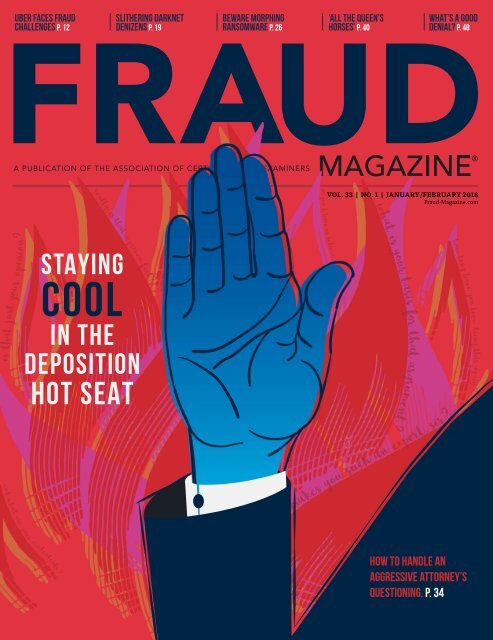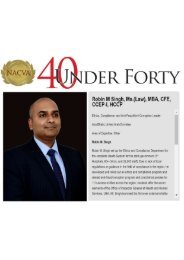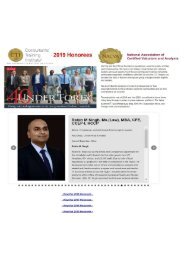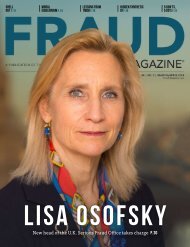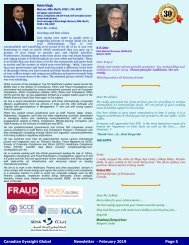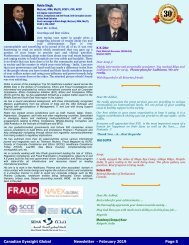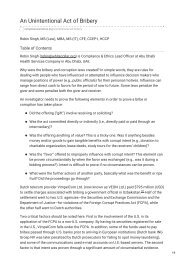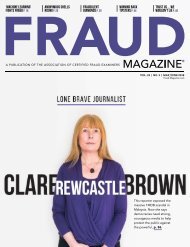ACFE - Cross Border Investigations (Part 1)
Confronting the challengesof #cross-border #fraudexaminations by #RobinSingh the #whitecollarinvestigator
Confronting the challengesof #cross-border #fraudexaminations by #RobinSingh the #whitecollarinvestigator
You also want an ePaper? Increase the reach of your titles
YUMPU automatically turns print PDFs into web optimized ePapers that Google loves.
UBER FACES FRAUD<br />
CHALLENGES P. 12<br />
SLITHERING DARKNET<br />
DENIZENS P. 19<br />
BEWARE MORPHING<br />
RANSOMWARE P. 26<br />
‘ALL THE QUEEN’S<br />
HORSES’ P. 40<br />
what’s a good<br />
denial? P. 48<br />
really, is that a proven fact?<br />
is that just your opinion?<br />
and what<br />
are your<br />
STAYING<br />
IN THE<br />
DEPOSITION<br />
HOT SEAT<br />
so you’d have us believe...<br />
VOL. 33 | NO. 1 | JANUARY/FEBRUARY 2018<br />
Fraud-Magazine.com<br />
what is<br />
your basis<br />
for<br />
that argrument?<br />
what makes you such an expert, sir?<br />
how long have you been doing this again?<br />
credentials?<br />
How to handle an<br />
aggressive attorney’s<br />
questioning, P. 34
FRAUD BASICS<br />
Fundamentals for all<br />
Confronting the challenges<br />
of cross-border fraud<br />
examinations<br />
<strong>Part</strong> 1 of 2<br />
Awhistleblower within our<br />
organization alleged that<br />
high-profile personnel were<br />
taking bribes, bypassing laws, creating<br />
conflicts of interest and harassing<br />
women — all in collusion with local and<br />
foreign offcials of a government aid<br />
agency that provided relief funds and<br />
educational scholarships.<br />
The allegations, which arose from<br />
a Middle Eastern country, implicated<br />
foreign offcials from a ministry of a<br />
country at war who’d colluded with a senior<br />
offcial from another country that<br />
followed the Western judicial system.<br />
We now had a complex case that crossed<br />
legal, judicial and cultural borders.<br />
During our investigation, we<br />
discovered that all the paper trails<br />
had literally been burned and electronic<br />
data destroyed because of a<br />
fire and a virus attack. We were left<br />
with no choice but to visit numerous<br />
cities in a country at war to check<br />
paper records at a university and a<br />
government ministry associated with<br />
the scholarships. Our evidence and<br />
witness statements suggested:<br />
• Candidates applying for scholarships<br />
(who were aspiring for better lives)<br />
at Western higher-education schools<br />
had paid “facilitation payments”<br />
(bribes) to scholarship ministry<br />
personnel.<br />
• The scholarship ministry had provided<br />
some funds to family members<br />
of ministry employees who didn’t<br />
have the requisite skill sets and<br />
qualifications.<br />
• Female scholarship recipients were<br />
sexually harassed under the guise of<br />
medical examinations in collusion<br />
with a hospital physician.<br />
We obtained enough evidence to<br />
suggest that some top managers had<br />
colluded with a few foreign offcials of<br />
a Western aid agency. Our investigation<br />
took another turn when we found<br />
that the mastermind of the scholarship<br />
scheme did indeed live in a country<br />
with well-established Western laws.<br />
So, we then had to research, study and<br />
understand those laws before we visited<br />
that Western country and interviewed<br />
offcials in their jurisdiction.<br />
You might eventually work on an<br />
internal fraud examination within your<br />
global organization that could cross several<br />
borders. You can immediately assume,<br />
of course, that your examination<br />
will be byzantine. If you don’t possess<br />
expert knowledge on international laws,<br />
procedures and cultural norms you’ll<br />
have to add team members who do.<br />
In part one of two parts, I’ll cover<br />
what triggers a cross-border fraud examination,<br />
determining if an allegation<br />
is true or vindictive, who should be notified<br />
and how to begin your planning.<br />
Triggering a cross-border<br />
fraud examination<br />
These examinations can arise in a multitude<br />
of ways, but the most common<br />
reason is from an employee accusation,<br />
according to “<strong>Cross</strong>-border investigations:<br />
Are you prepared for the challenge?”<br />
KPMG International, 2013,<br />
tinyurl.com/ycn66vej. (See Figure 1 on<br />
page 10.)<br />
According to KPMG, 32 percent of<br />
those internal accusations come from<br />
anonymous whistleblower hotlines,<br />
which protect employees from potentially<br />
negative repercussions. And 45<br />
percent of the accusations come from<br />
employee leads inside the company<br />
other than whistleblower programs.<br />
According to the 2016 <strong>ACFE</strong> Report<br />
to the Nations of Occupational Fraud and<br />
Abuse, the most common detection<br />
method — not necessarily all involving<br />
cross-border examinations — was tips,<br />
39 percent. And organizations that had<br />
hotlines were much more likely to detect<br />
fraud, 47.3 percent. (See <strong>ACFE</strong>.com/rttn.)<br />
Fraud examinations can also begin<br />
from internal audit findings, outside<br />
source allegations and other enforcement<br />
agency findings, according to<br />
KPMG. How an organization receives<br />
and deals with an allegation can be a<br />
8 FRAUD MAGAZINE JANUARY/FEBRUARY 2018 FRAUD-MAGAZINE.COM
By Robin Singh, CFE, LPEC,<br />
CFAP<br />
defining moment. You don’t want to<br />
encroach on someone else’s authority<br />
before the investigation has even begun.<br />
Many organizations — faced with<br />
internal fraud — might follow their legal<br />
counsels’ advice to defensively keep<br />
their fraud examinations quiet because<br />
they value their reputations.<br />
Company leaders might ask, “Can’t<br />
we just informally talk with a few people<br />
internally and see what happened?”<br />
Well, the answer is yes, but if you discover<br />
problems, you’re going to have to<br />
go back and repeat your initial examination.<br />
If you detect a global cross-border<br />
fraud, it’s best to do it right the first time<br />
and plan a full-scale fraud examination<br />
that will laboriously inspect the corners<br />
of your far-flung corporation.<br />
Determine if an allegation<br />
is true or vindictive<br />
It’s diffcult to differentiate between<br />
true allegations and vindictive hoaxes.<br />
A thin line often separates truth and<br />
fiction. Here are some steps that can<br />
potentially help differentiate the two:<br />
• Diligent, thorough fact-finding.<br />
Utilize confidential resources within<br />
the firm, such as risk managers,<br />
the legal department, the COO and<br />
the CEO, to understand if problems<br />
similar to the allegations exist. (However,<br />
of course, if top management is<br />
involved they’ll plead ignorance.)<br />
• Review personal files of the whistleblower<br />
and the potential alleged<br />
fraudster. The whistleblower, possibly<br />
a longtime employee, might have scars<br />
from past events at the firm. A new<br />
employee still might have vindictive<br />
complaints or grudges even after a<br />
couple of appraisal cycles. If a newcomer<br />
tries to be a problem child, the<br />
surroundings will identify it for you.<br />
For example, an employee holding a<br />
grudge against their supervisor for not<br />
granting them a good bonus would<br />
likely discuss or show signs of frustration<br />
to their colleagues. Thus, while<br />
collecting initial intel on the case,<br />
whistleblowers or the potential alleged<br />
fraudster, assess the surroundings in<br />
detail to create a linked analysis.<br />
• Review the whistleblower’s and<br />
the potential alleged fraudster’s<br />
annual conflict-of-interest and<br />
vendor-sponsorship declarations<br />
and trainings they’ve attended to<br />
evaluate how they’ve understood<br />
the purposes of these mandatory<br />
anti-fraud regulations.<br />
• “Innocent until proven otherwise” is<br />
my motto for both parties. Give them<br />
both a fair chance. Also, disclosing<br />
their names to anybody not involved<br />
in the investigation can be detrimental<br />
to their future jobs and earnings<br />
plus possibly be harmful to their<br />
families. Once you have at least some<br />
vague hints toward the potential allegations,<br />
discuss with legal counsel.<br />
If you’ve been with the firm three<br />
or four years you’re probably soaked in<br />
the business culture, and your radar is<br />
attuned. So, you have a good idea when<br />
something just doesn’t “seem right.”<br />
Include this line in your whistleblowing<br />
policy: If individuals deliberately<br />
make false or malicious allegations, the<br />
organization will take disciplinary action<br />
against them.<br />
This might deter some malicious<br />
complaints from an anonymous<br />
whistleblower.<br />
Determine who<br />
should be notified<br />
The first step in the process is to alert<br />
upper-level management that a whistleblower<br />
has made an allegation, and the<br />
organization will begin an examination.<br />
Tell only those who need to know; you<br />
don’t want to taint the investigation’s<br />
integrity. However, in some countries<br />
it’s not uncommon to alert several tiers<br />
on the organizational chart. Just be<br />
sure to understand the area’s customs<br />
and policies on this. Your investigation<br />
committee (see below under “Plan for a<br />
successful investigation”) always helps<br />
in this case.<br />
This multidisciplinary standing<br />
committee consists of employees<br />
from the legal, compliance and risk<br />
departments (and others) who oversee<br />
investigations from procedural rather<br />
than substantive points of view. The<br />
committee provides insights into the<br />
organization’s culture, unspoken rules,<br />
and key policies and procedures plus<br />
manages and monitors the activities of<br />
outside investigators.<br />
Plan for a successful<br />
fraud examination<br />
An organization must respond quickly<br />
and effectively to any allegations with<br />
a well-developed, general cross-border<br />
plan.<br />
Everyone in the organization<br />
should be prepared with specific,<br />
predetermined protocols that cover<br />
standards, principles, region- or<br />
country-specific requirements, customs<br />
and practices.<br />
A key part of this plan is clear communication.<br />
Don’t fail to realize until<br />
it’s too late that you can’t overcome language<br />
barriers because you didn’t have<br />
proficient translators on your team.<br />
Here are components common to<br />
successful cross-border examinations:<br />
• Calm, clear mindset of the lead investigator<br />
(especially when working in a<br />
hostile environment, such as Afghanistan<br />
or Iraq).<br />
• Determination of the time frame<br />
within an investigation.<br />
• Data privacy ensured.<br />
FRAUD-MAGAZINE.COM JANUARY/FEBRUARY 2018 FRAUD MAGAZINE 9
FRAUD BASICS<br />
Fundamentals for all<br />
Which of the following has been the primary trigger of most of your<br />
company’s recent cross-border investigations?<br />
Internal audit finding<br />
Leads provided by someone (employee)<br />
inside the company (other than whistleblower<br />
program)<br />
Leads provided by someone outside the<br />
company (other than a regulatory body or<br />
law enforcement)<br />
Notification by regulatory authority or law<br />
enforcement<br />
Red flags or findings arising from compliance<br />
due diligence<br />
Whistleblower program<br />
privacy and confidentiality, company<br />
property and potential evidence.<br />
As a lead investigator, with consent<br />
from management, here are the steps<br />
you should take when you unearth an<br />
issue and you’ve determined the credibility<br />
of the allegation:<br />
• Understand the underlying substantive<br />
issue involved in the allegation.<br />
• Ensure objectives are clear and<br />
defined.<br />
• Clearly establish a reporting structure<br />
with points of contact.<br />
• Alert your standing investigation<br />
committee.<br />
• Begin an investigation diary.<br />
Figure 1: Primary triggers of most cross-border investigations.<br />
How important are the following to the execution of a successful<br />
cross-border investigation?<br />
Hiring the right external resources<br />
Effectively utilizing internal resources (including people and technology tools)<br />
Managing expectations of senior management<br />
Having a detailed investigation plan<br />
Effective communications throughout the course of the investigation<br />
Proper planning and identifying the scope<br />
Least important<br />
Note: Chart shows average score for each success factor.<br />
Most important<br />
• Determine the documents and data<br />
you need to compile to conduct the<br />
examination.<br />
• Devise a data security strategy.<br />
• Keep a current backup copy of<br />
e-documents.<br />
• Identify relevant witnesses to whom<br />
the fraud examiners should be<br />
speaking.<br />
• Develop credible communication<br />
channels with the whistleblower/<br />
informant if they’ve disclosed their<br />
name(s). Draw a linked analysis with<br />
the known facts and those provided<br />
by the whistleblower. You’ll fill in the<br />
gaps later. Use the analysis to match<br />
the potential wrongdoings.<br />
Figure 2: Important elements for the execution of a successful cross-border<br />
investigation.<br />
• Clear and timely transfer of information,<br />
notifications and deadlines to<br />
employees or their representatives<br />
plus governmental agencies and law<br />
enforcement.<br />
• Determination of the type, jurisdictional<br />
authority and time frames in<br />
which possible disciplinary action(s)<br />
will be taken.<br />
• Determination of cost parameters.<br />
• Also, see Figure 2 above, “Important<br />
elements for the execution of a successful<br />
cross-border investigation.”<br />
Always take baby steps when<br />
creating your examination plan. If you<br />
don’t construct it well, you’ll reenact the<br />
Battle of Waterloo. You want to protect<br />
the integrity of all players, the process,<br />
• Choose a subject matter expert (SME)<br />
who can help you make early decisions.<br />
Always run the evolving investigation<br />
plan by the SME whenever<br />
possible. Assign a backup team member<br />
to replace the SME if that person<br />
has to return home for personal,<br />
health or performance reasons.<br />
(See Figure 3 on page 11 for the<br />
KPMG report’s participants’ responses<br />
on the nature of their cross-border<br />
investigations.) n FM<br />
10 FRAUD MAGAZINE JANUARY/FEBRUARY 2018 FRAUD-MAGAZINE.COM
NEW SELF-STUDY COURSE!<br />
Consumer Fraud<br />
$139 Members / $179 Non-Members<br />
Which of the following best describes the<br />
nature of cross-border investigations you<br />
are performing or managing?<br />
Bribery and<br />
corruption/FCPA<br />
Embezzlement or<br />
misappropriation<br />
Conflict of interest<br />
Fraudulent financial<br />
reporting<br />
CPE Credit<br />
10<br />
Course Level<br />
Basic<br />
Prerequisite<br />
None<br />
Data breach<br />
Industry-specific<br />
regulatory issue<br />
Figure 3: Nature of cross-border investigations.<br />
In part two of the March/April issue: assessing<br />
legal and cultural considerations, specifics of your<br />
plan, reporting findings and remediation across<br />
borders.<br />
As a Certified Fraud Examiner and an anti-fraud expert, your community<br />
looks to you for guidance related to fraud. This course will provide<br />
you with an increased awareness and understanding of common<br />
consumer fraud schemes. Additionally, Consumer Fraud will provide<br />
you with resources and remedies to detect, deter, report and prevent<br />
these schemes — enabling you to better protect yourself and your<br />
community from becoming victims.<br />
Robin Singh, CFE, LPEC, CFAP, is the compliance<br />
and fraud control department lead offcer<br />
at Abu Dhabi Health Services Company – SEHA<br />
(Government of Abu Dhabi). His email address<br />
is: robinsingh002@yahoo.com.<br />
The opinions expressed in this column are those of<br />
the author and don’t reflect the opinions of SEHA or<br />
its business entities or its affliates. All figures are<br />
sourced from “<strong>Cross</strong>-border investigations: Are you<br />
prepared for the challenge?” KPMG International<br />
2013.<br />
Key Takeaways:<br />
• Ways to protect yourself and others from becoming victims of<br />
consumer fraud schemes<br />
• Techniques used to commit consumer fraud schemes<br />
• Effects of consumer fraud on consumers<br />
• Trends and statistics on consumer fraud<br />
Available Formats: Online, Printed Workbook and PDF Workbook<br />
Visit <strong>ACFE</strong>.com/ConsumerFraud to learn more.<br />
FRAUD-MAGAZINE.COM JANUARY/FEBRUARY 2018 FRAUD MAGAZINE 11


